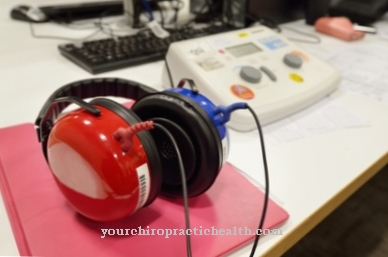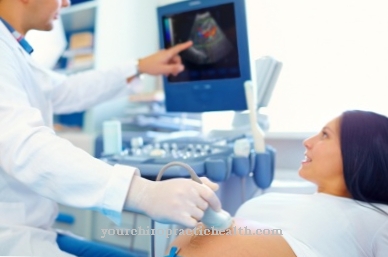inhalation is the targeted inhalation of aerosols, gaseous active substances or hot water vapor. The process can take place with pure water, chamomile, table salt, eucalyptus oil or other healing herbs or essential oils. The mucous membranes of the airways are cleaned and the entire blood circulation is strengthened.
Inhalation is always used when specific diseases of the respiratory tract have to be treated. It is also a component of pain relief and anesthesia in anesthesia.
What is the inhalation?

Inhaling active ingredients or water as a therapeutic application goes back to ancient times. The healing effects of the salty sea air were already known to the ancient Greeks, who could observe a relief of respiratory diseases. Modern inhalation therapy begins in 1956. The first propellant-powered devices could be developed at this time and appear on the market until the first dry powder inhaler established itself in 1971.
However, since the inhalers still used CFCs, which were then banned throughout the EU in 1989, alternative solutions had to be found. The spectrum of new inhalation devices was wide and quickly offered many possibilities to treat various diseases and complaints more intensively and at the same time more gently.
Function, effect & goals
Inhalation now takes place using two different methods. Firstly, the mucous membranes of the airways are moistened, and secondly, a drug is administered by inhalation. The latter in particular is a valuable addition to the treatment of z. B. Chronic lung diseases.
During inhalation by moistening the respiratory mucosa, the mucus gradually loosens and the secretion is coughed up. The lungs have their own cleaning function, which is supported by the inhalation process. For this purpose, saline solutions are used that correspond to the body's own concentration. To get deeper into the lower airways, there are various inhalation systems such as: B. Nebulizer.
An important part of such treatment is aerosol therapy.Liquids, especially saline solutions, are atomized and deeply inhaled through the mouth or nose. Aerosols are produced by electric steam or ultrasonic nebulizers or also by means of a compressed air atomizer, so that large particles can be atomized in a very short time. Especially when the mucous membrane of the respiratory tract is attacked, this type of therapy achieves a considerable improvement, also supports self-healing and has a preventive effect against new respiratory diseases.
An ultrasonic nebulizer is a device that creates fine water mist. For this purpose, electrical vibrations are converted into mechanical ones and transferred to the water to be inhaled. In this way, tiny droplets are formed that not only reach the nose, throat, mouth and mucous membranes, but also enable deep penetration into the airways, right into the windpipe and bronchi.
Another type of inhalation is the partial steam bath, preferably in the case of a cold, inflammation in the throat, mouth and paranasal sinuses. In the same way, skin impurities can be combated or a dry nose can be moistened. This in turn causes a more intensive cleaning of all dirt, dust and pollen loads.
To dissolve the mucus, water vapor is inhaled through a pot or bowl, which enters the upper respiratory tract in particle form and improves the symptoms there. However, the water must not be boiling hot. A temperature of around 60 degrees Celsius is sufficient.
Salts or essential oils are added to support the inhalation, but only for inhalations that are not carried out via inhalation devices, as the nozzles can become clogged with these. Since both moisture and heat develop their effects, a towel that is placed over the head is helpful during inhalation so that less steam escapes. It is also not important to breathe particularly deeply above the water vapor, but rather regularly, while maintaining a safe distance so as not to burn yourself.
An alternative to the pot is the steam inhaler. In this case, the water vapor is absorbed through a mask over the nose and mouth. The efficiency is also only limited to these areas, so that the face itself, including eyes and ears, are not affected.
Risks, side effects & dangers
In the case of medicinal inhalation, a distinction is made between short-acting and long-acting drugs that expand the airways. The absorption of the active ingredients depends on the solubility properties and the particle size of the substances to be inhaled.
The effect of such inhalation is the better penetration of the medication into the diseased areas. On the one hand, this results in a faster effect of the drug; on the other hand, a smaller amount of drug is required than z. B. when taking a tablet. This in turn ensures that the side effects are kept within limits and that the body and organs are not so stressed. Such drugs that are inhaled include: a. Cortisone, various antibiotics, and beta-2 sympathomimetics.
During the inhalation process, the natural breathing process is used to transport the active substance into the airways and the respiratory mucous membranes. Both solid and liquid medication are inhaled through fine particles or droplets and can develop their effects.
Inhalation is particularly useful for respiratory problems, asthma and coughs, sinus infections and runny nose, helps with eye problems, various skin diseases, circulatory problems or very low blood pressure. Mucus caused by diseases such as acute bronchitis, chronic sinusitis, pneumonia, cystic fibrosis or COPD can also be loosened by inhalation. Antibiotic inhalations are a suitable measure for such complaints and must be carried out as a continuous inhalation.
























.jpg)



